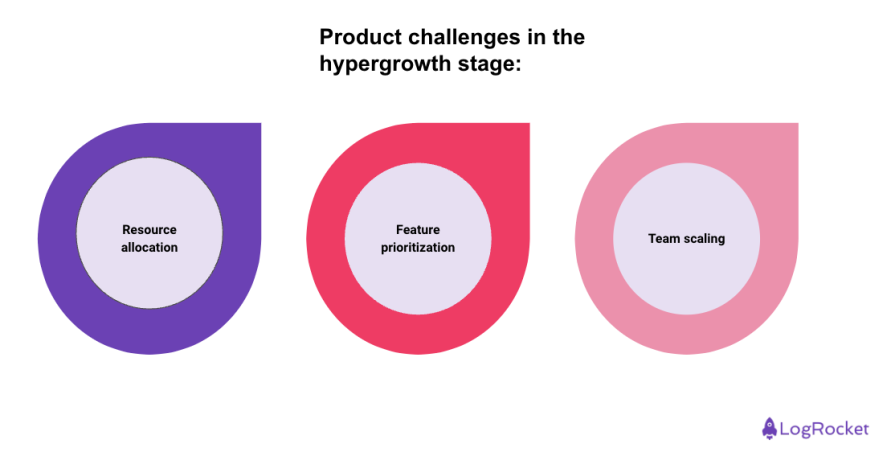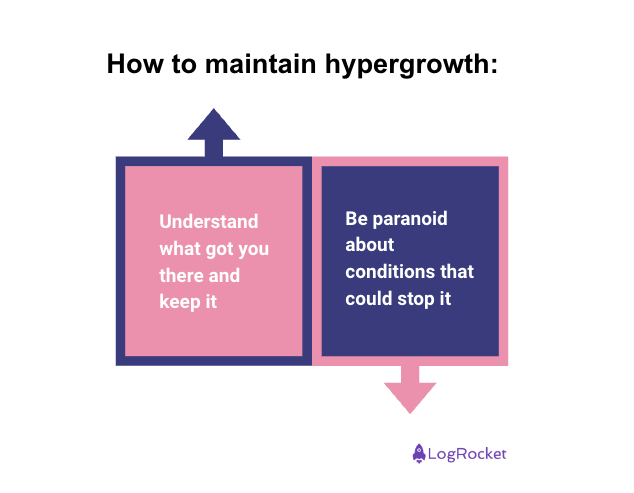Creating a successful business is challenging. You encounter so much risk and uncertainty on the way that even the bravest of founders’ live in a world of stress and doubt for months on end. Eventually, you hope that you can achieve product market fit and watch your product sell.

However even at that stage, you can’t relax and simply let your hard work pay off. Instead, a new stage of business development called hypergrowth begins. Based on your action in this phase you may observe your product grow its user base for years, or you can squander everything by acting incorrectly.
So what is this hypergrowth, and how can you ensure that it doesn’t end prematurely? All that and more in today’s piece.
Hypergrowth happens when a company experiences an exceptionally rapid rate of expansion, typically more than 40 percent annual growth. It’s the phase where everything accelerates: revenues soar, user numbers skyrocket, and the company scales faster than anyone expected.
Hypergrowth doesn’t happen by chance. It’s fueled by factors such as:
The typical stages of hypergrowth include:
As mentioned in the intro, hitting hypergrowth doesn’t mean that the hard work can come to a close. It’s just a different form of another massive challenge. Because of this, you should be aware of the following challenges:

Before hypergrowth, the development goal is easy: Do whatever it takes to create a successful product and all bets are off. It’s all about rapid prototyping and development and the coding happens like there’s no tomorrow.
However, during hypergrowth, you need to start the classical juggling of maintenance versus innovation. On one hand, the product now needs a little (more likely massive) cleanup behind the scenes to ensure it’ll work and work well for the foreseeable future. On the other hand, the product is likely not “feature-complete” and there are still massive opportunities for additional growth acceleration. At this stage, your competition is realistically aware of your success and will try to replicate your successful formula.
I believe that for most products a 70-30 or 80-20 split between innovation and maintenance should work out great. Alternatively, I’d consider spending, on average, every 4th spring entirely on maintenance while working on new features during other sprints.
With rapid growth, there’s pressure to add new features. However, not all features align with core user needs or business goals. Prioritization is key.
At this stage, you can no longer operate with a small Excel sheet or Kanban board and just put whatever feels most important on top. Your prioritization process should become more formalized.
While it always feels great to add something “cool” to the product and fix a pesky bug, you always need to estimate your return on investment with every product update.
Product success will inevitably lead to expanding the team. In the influx of money and demands coming in, it’s only natural that the original rag-tag team, who built the initial successful version of the product might not be enough. Thus, there are two aspects of this challenge: hiring the right number of the right people and making sure they can integrate with the team quickly and efficiently.
From your perspective, the number of people needed should be determined, again, by the expected return on investment. Each person, even with an abundance of cash, needs to be hired for a specific purpose and with reasonable goals in mind.
For example, you can request to hire a backend team to work on the product’s architecture and stability and allow the current team to focus on the frontend and the actual client experience, which they excel at as they built a product that entered the hypergrowth stage in the first place.
As mentioned, while entering this stage feels like a great accomplishment, the truth is that a lot can squander the success and goodwill of the users. As I observe the market, there are two major ways companies fail to sustain their hypergrowth:
While it’s a big word, I believe it nails the problem. Sometimes you have such a streak of success that you think it can’t possibly end. This downfall can originate in different ways. Below are some of these ways alongside real-world examples:
Adobe Creative Cloud — Adobe has faced criticism for its subscription pricing model, with frequent price hikes that some users consider steep, especially for freelancers and small businesses
Salesforce — Known for its comprehensive CRM solutions, Salesforce has been criticized for complex pricing tiers and significant costs that can escalate quickly with added features or users that were not necessarily all that needed
Dropbox — Introduced limitations on the number of devices that free users can sync, pushing users toward paid plans. I believe Dropbox’s hubris is one of the reasons why strong competition in the form of OneDrive and Google Drive could emerge
Microsoft Office 365 — Shifted from one-time purchases to subscription-based models, which some consumers find less favorable compared to owning the software outright. Not to mention bundling way too many pieces of software (for more on this check out my recent piece on unbundling)
Skype — While popular for a very long time, at some point it really lost its way and identity when the “stories” feature was added inspired by Instagram. It shouldn’t be a shock that a social media feature didn’t exactly fit into a communicator
Jira — Atlassian’s project management tool has been criticized for feature bloat, making it overwhelming for new users
QuickBooks Online — Users have reported slow load times and downtime, affecting their ability to manage finances efficiently
SAP Cloud Services — Some clients have experienced performance issues and delays in updates, impacting business operations
However, hubris isn’t the only thing that can kick a product off its hypergrowth. The other one is:
Hypergrowth can happen due to having a product at the right place at the right time (Zoom in the Pandemic) or by working hard to improve the product to get a great market fit (Microsoft Office, Photoshop). However, on the way to hypergrowth and especially beyond, the market and user expectations can change like crazy.
Successful, long-term hypergrowth is as much about understanding the magic that triggered it, as it is changing the product to keep up. Here are some examples of where successful companies failed to do that:
Nokia was once the global leader in mobile phones, renowned for its durable hardware and user-friendly interfaces. In the early 2000s, Nokia dominated the market with a wide range of devices catering to various consumer needs. However, the introduction of smartphones revolutionized the industry. Companies like Apple and Google redefined user expectations with touchscreen interfaces and app-centric ecosystems.
Nokia’s reluctance to pivot from its Symbian operating system to more advanced software platforms hindered its ability to compete. The company underestimated the importance of software and overemphasized hardware, failing to recognize the smartphone as a computing device rather than just a communication tool. By the time Nokia adopted Microsoft’s Windows Phone platform, it had lost significant market share.
The lack of timely innovation ultimately killed its hypergrowth, leading to the sale of its mobile division to Microsoft in 2014. There, the story basically repeated with Nokia’s second downfall, as Windows Mobile failed to understand what made iOS and Android the leaders and follow those features.
Kodak was a pioneer in photography, once holding a dominant position in the film and camera industry. Ironically, Kodak invented the first digital camera in 1975 but shelved it to avoid disrupting its lucrative film business. The company believed that digital photography was a threat rather than an opportunity.
As digital cameras became mainstream, Kodak failed to adapt its business model. Competitors embraced the digital revolution, offering consumers new ways to capture and share images. Kodak’s late entry into the digital market could not compensate for its earlier inaction. The company’s reluctance to innovate led to bankruptcy in 2012. Kodak’s decline illustrates how ignoring technological advancements can derail hypergrowth and lead to obsolescence.
BlackBerry, formerly known as Research In Motion (RIM), was an elite brand in the mobile phone industry, especially among business professionals. Its devices featured physical keyboards and secure email services, which were highly valued at the time. However, the launch of Apple’s iPhone in 2007 and the subsequent rise of Android smartphones shifted consumer preferences toward touchscreen devices with extensive app ecosystems.
BlackBerry was way too slow to respond to these changes, clinging to its physical keyboard design and proprietary operating system. Despite attempts to revitalize its product line, BlackBerry could not regain its former prominence.
Blockbuster was once the leading video rental company, with thousands of stores worldwide. The emergence of digital streaming services, most notably Netflix, transformed how consumers accessed movies and television shows.
Blockbuster’s failure to innovate and adapt to the digital landscape led to its downfall. The company underestimated the convenience and potential of online streaming and mail-in rentals. As consumer behavior changed, Blockbuster’s revenues plummeted, resulting in bankruptcy in 2010. This case underscores the importance of embracing innovation to sustain growth.
To keep your product in hypergrowth, remember these two key points:

Whether it was accidental or calculated, some elements of your product or marketing made it so that the product was successful and started growing. It’s crucial to invest in discovery to identify and protect what made it happen. I think a silly, yet perfect, example is the $1.50 hotdog combo deal at Costco. Its steady price, while it didn’t build the store’s success, became legendary, and moving a cent here would cost uproar and lots of negative press.
That said, you also need to:
At least once per week, you need to look at data and put on your paranoid, worst-case-scenario hat, to figure out how to maintain growth. For example, if Nokia hadn’t dismissed the iPhone and followed in its tracks with at least one touch-based smartphone model, perhaps Nokia would still be one of the top phone companies to this very day.
Navigating the hypergrowth phase is a blessing and a curse. As a PM, you can’t afford to rest on your laurels once you’ve hit rapid expansion. Instead, you need to stay vigilant, adaptable, and always focused on what brought you success in the first place.
Hitting hypergrowth isn’t where the hard work ends. It’s when it actually begins. It’s an opportunity to solidify your product’s place in the market for years to come. By avoiding the pitfalls of hubris and complacency, and by continuously innovating, you can sustain that growth and lead your product to long-term success.
Featured image source: IconScout

LogRocket identifies friction points in the user experience so you can make informed decisions about product and design changes that must happen to hit your goals.
With LogRocket, you can understand the scope of the issues affecting your product and prioritize the changes that need to be made. LogRocket simplifies workflows by allowing Engineering, Product, UX, and Design teams to work from the same data as you, eliminating any confusion about what needs to be done.
Get your teams on the same page — try LogRocket today.

A practical guide for PMs who want to stop being bottlenecks, delegate smarter, and lead teams effectively with a clear ownership framework.

Stop letting unreliable data block features. Treat data as inventory to track quality, ownership, and ship with confidence.

Learn why slide decks slow teams down and explore better tools like whiteboards, PRDs, and prototypes to improve collaboration and alignment.

AI PM roles are evolving fast. Learn the five types of AI PMs, the skills they need, and how they shape AI products across industries.